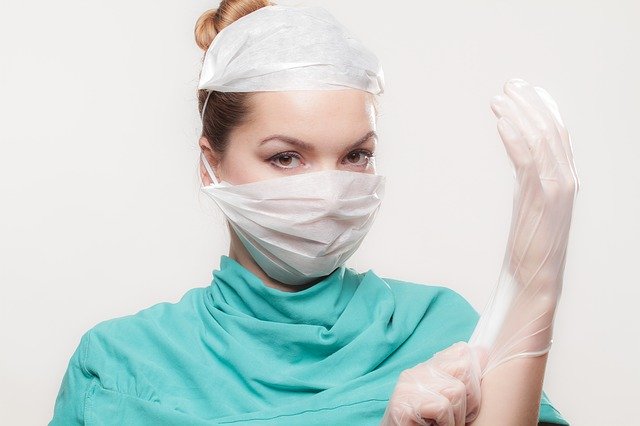COVID-19 can be spread by a person who has been infected before symptoms occur, if they have mild symptoms, if they have obvious symptoms, and for a short period of time after they feel better.
During the 1-2 days before people feel ill there is a rapid build-up of the virus in the body, and many virus particles can be expelled through coughing or sneezing during this time. “Researchers estimate that around 44% of infections are passed on by people who are not showing any symptoms,” the Western Cape government said in a new policy announcement.
“Virus particles can survive in the air for a short period of time and can remain on hard surfaces such as plastic or steel for a few days, if not removed with regular cleaning.”
COVID-19 is spread by contaminated hands touching the hands of others and touching things such as money, credit cards, door handles and counters. When you then touch your eyes, nose and mouth after you have touched other people’s hands and things with COVID-19 on it, then you can get infected.
General measures to protect against infection:
- Social distancing (1,5 square metre) distancing from any other person in any circumstance. This includes any bodily contact such as handshakes. Greet people without making any physical contact.
- Wash hands with soap and water for 20 seconds, or use alcohol-based hand sanitiser after contact with any person or after contact with frequently touched surfaces (e.g. keyboards, screens, phones, door handles, work surfaces).
- Cough/sneeze etiquette (cough in the fold of the elbow or in a tissue which you discard and wash your hands) remain the mainstay of protecting yourself and others.
- Avoid touching your eyes, nose and mouth with unwashed hands.
- Surfaces that are frequently touched, e.g. toilet door handles, etc, should be cleaned with diluted bleach disinfectant (20 ml bleach per litre water) hourly, or less frequently depending on the circumstance.
- General housekeeping eg. the cleaning of keyboards, telephones, handbag bottoms.
- People who feel ill should stay at home. Create 1,5m distance from others and be extra vigilant about environmental hygiene.
- Avoid any place where there is a form of crowding as far as possible.
- Support others to comply with the golden rules.
The various forms of personal protective equipment (PPE):
PPE is classified into categories: eye and face protection (plastic shields), hand protection (various types of gloves), body protection (coats), respiratory protection (depending on risk – masks).
Regarding masks:
Masks are in general more recommended for health workers.
– The World Health Organisation (WHO) recommends that for public-level control of COVID-19 only symptomatic people or their carers wear a face mask.
– When masks are worn, they recommend that users follow correct safety procedures.
– If you are healthy and apply the golden rules, and are not caring for someone with COVID infection, you do not need a mask.
– As COVID-19 prevalence may increase in communities, we recommend the consideration of alternatives to surgical masks with careful consideration for usage guideline.
– When travelling in a private vehicle or visiting a supermarket, NO PPE (no mask or gloves) is required.
– Masks are only effective when used in combination with the other golden rules of prevention listed above.
– Surgical masks do provide sufficient protection against the distribution of droplets that are created by coughing, sneezing, speaking loudly/shouting. As the epidemic unfolds the use of face masks by all people who are at risk of exposure, even if not sick is a recommendation.
N-95 respirators – These are reserved for health care workers at the clinical interface.
“As COVID-19 prevalence may increase in communities, we recommend the consideration of alternatives to medical masks with careful consideration for usage guidelines,” the Department of Health said.
Cloth masks are not ideal, they do provide some protection, yet reduced protection compared to surgical masks. They may be considered when the stage of the epidemic requires extensive measures and surgical masks are in short supply.
The handling of cloth masks needs to be done with care due to the risk of it becoming a source of infection. the material and inner lining need to be different. Denim, calico or similar thick weave cotton should be used and filled with soft cotton.
However, to improve the filtration one can use a water-resistant membrane cloth inside to prevent transmission of droplets. Cloth masks to be washed with warm soapy water and dried in the sunlight.
Technique related to the handling of masks:
Before putting on a mask, clean hands and fit mask tightly on the face, covering the nose and mouth. Do not fiddle with the mask. Avoid letting the mask get wet. To remove the mask, remove it from behind (do not touch the front of the mask), and discard immediately in a closed bin and clean hands.
Regarding gloves:
There is little evidence that gloves are useful as a method of protection for members of the public. Wearing gloves and touching infected surfaces and then touching your face is the same as touching with a bare hand. It provides a false sense of security, does not prevent the transmission of the virus, leads to sweating of the hands and may cause allergy.
Picture: Pixabay

